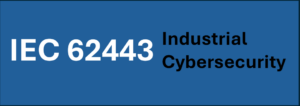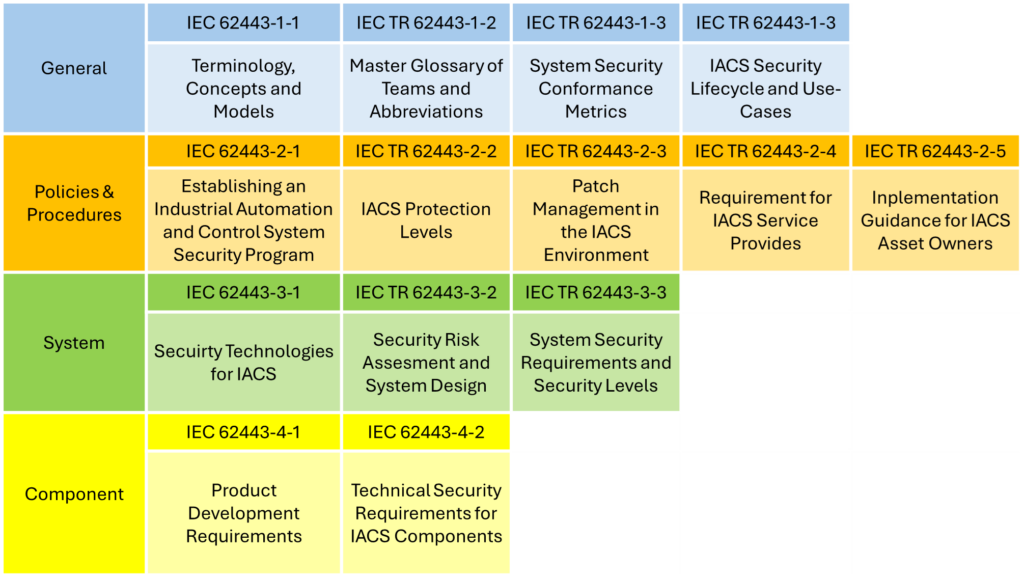IEC 62443 – Industrial Cybersecurity

IEC 62443 is a comprehensive set of standards developed to address cybersecurity in Industrial Automation and Control Systems (IACS). These standards provide guidelines for securing systems in industrial environments, including power plants, factories, and critical infrastructure.
The series is designed to address risk management, cyber resilience, and system security in industrial operations, ensuring safe and secure communication, data integrity, and overall system protection.
Importance of IEC 62443
IEC 62443 ensures industrial systems are protected against cyber threats that could disrupt operations or cause harm to personnel, infrastructure, and the environment.
The standard is particularly important in protecting critical infrastructure from cyber-attacks, ensuring business continuity and operational reliability.
Compliance with IEC 62443 is often required by regulators and industry stakeholders to ensure industrial systems meet cybersecurity best practices.
Key Elements of IEC 62443
– Security Levels (SLs): Defines four security levels (SL1 to SL4) based on the degree of threat or attack resistance required.
- SL1: Basic protection against unintentional mistakes or simple attacks.
- SL2: Protection against intentional misuse by unauthorized insiders or easily accessible cyber tools.
- SL3: Protection against sophisticated attacks by hackers with skills, tools, and moderate resources.
- SL4: Advanced protection for systems that are likely to be attacked by highly skilled professionals with significant resource
– Risk Assessment and Management: Establish a thorough understanding of system vulnerabilities and prioritize them based on potential impact.
– Security Architecture: Implement security controls across multiple layers of the system architecture, including hardware, software, and network components.
– Access Control: Define and manage who can access critical parts of the system to prevent unauthorized actions.
– Monitoring and Response: Implement systems to detect potential cybersecurity threats and establish a response plan to mitigate risks.
Scope of Application
IEC 62443 applies to Industrial Automation sectors, such as energy, manufacturing, oil and gas, transport, and water.
It is used to secure industrial control systems (ICS), supervisory control and data acquisition (SCADA) systems, and distributed control systems (DCS) from cyber threats.
Steps for Implementing IEC 62443
- Risk Assessment: Conduct a risk assessment to identify potential vulnerabilities in industrial systems.
- Security Design: Develop security architecture in line with the required security level (SL).
- Access Management: Set up strict access control mechanisms, ensuring only authorized personnel can access critical assets.
- Monitoring: Deploy security monitoring tools to detect anomalies and respond to potential threats in real time.
- Response and Recovery: Develop and implement an incident response plan to minimize the impact of cyber-attacks and quickly restore operations.
Benefits of IEC 62443
– Enhanced Security: Provides a robust framework for protecting industrial systems from cybersecurity risks.
– Regulatory Compliance: Ensures that organizations comply with national and international cybersecurity regulations for critical infrastructure.
– Operational Resilience: Enhances the cyber resilience of industrial operations, ensuring systems can withstand and recover from cyber incidents.
Overview

Resources and Guidance
– IEC 62443 Documentation: Read more regarding the official IEC-62433-standards here.
Latest Updates and News
New Threats in Industrial Cybersecurity: Stay informed on the latest trends in cyber threats targeting industrial control systems.
Contact Information
For consultancy assistance with 62443 Industrial cybersecurity, email us at info@scengineering.dk or use the contact form.